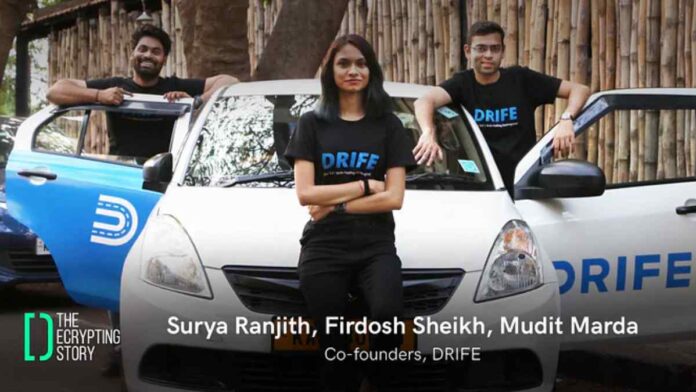Firdosh Sheikh, an entrepreneur, is creating a blockchain-based ride-hailing service with no driver commission, market-dictated pricing, open governance, and transparency. Surya Ranjith, and Mudit Marda, are partnering with Firdosh Sheikh in the venture.
Ride-hailing services are becoming more difficult to utilise in Indian metros due to a lack of available taxis, ride cancellations, and pricing increases. Drivers using Ola and Uber confront a unique combination of obstacles, including growing fuel expenses, substantial and opaque commissions paid to ride-hailing partner apps, difficulties making EMI payments, and so on.
Entrepreneur Firdosh Sheikh feels that utilising blockchain technology to address current difficulties is the best way forward.
Firdosh and co-founders Surya Ranjith and Mudit Marda are designing a ride-hailing service with 0% commission taken from drivers, market-dictated pricing, open governance, and transparency via the Bengaluru-based blockchain project Drife (started in 2021).
Ride-hailing companies are billion-dollar businesses, but its drivers struggle to make ends meet. This demonstrates how flawed the system is.
Drife, an early-stage startup, is already operational in Bengaluru, with the greatest concentration of its blue-and-white vehicles near Kempegowda International Airport.
According to Firdosh, the firm completes around 1,000 rides every week. The rides may be reserved via the company’s Android and iOS apps.
A consumer using Drife, as on other ride-hailing applications, must input a pickup and drop location to discover the nearest drivers.
However, in comparison to Uber and Ola, Drife now provides a lot more freedom to users and drivers.
“In addition to the base fee for the ride, each driver eager to accept it can quote a greater or lesser price for it,” Firdosh continues. “Drivers are aware of all aspects of a ride before accepting it and proposing a charge.
We are attempting to be fair to both consumers and drivers by allowing them to select the price of a journey rather than us choosing it for them “she claims.
Drife is now residing in Bengaluru. Transparency in travel costs The basic wage is determined by the tariff rate imposed by the local government, as well as the time and distance involved.
The quantity is not affected by the current supply-demand situation at any particular time.
“There are no hidden multipliers that raise travel fees at different times,” she explains.
Firdosh demonstrates using the example of a Rs 2,000 Uber cab journey. Assuming commission requirements are followed, she claims the driver will earn 80% of the fare (Rs 1,600), with the remainder going to Uber.
Several drivers, however, continue to complain that ride-hailing firms take fees of up to 30-40%. In actuality, drivers may receive significantly less than they anticipate.
The lack of openness surrounding the algorithms used to compute price and fees has prompted regulators to scrutinise ride-hailing applications.
“When Drife calculates base pay based on distance and time, we get a figure of roughly Rs 1,000.
She states that there is no commission at Drife and that the driver keeps the whole sum received during the journey. Firdosh believes that at scale, with several trips per day, this strategy can result in drivers earning more (and in a transparent manner) than they would on other platforms.
Drife’s income streams
The firm generates cash in other ways because there is no fee charged to drivers. It charges its driver-partners a minimal monthly subscription fee of Rs 2,500, which allows them to accept, bid for, and execute rides on the site.
Aside from that, we’re developing a franchise model in which people in other places may possibly oversee Drife’s operations.
Building technology for ride-hailing in new places is lucrative but taxing, therefore we choose the finest possible parties who can operate operations abroad. Drife, unlike several blockchain apps, is not a Web3 solution looking for a problem to solve.
The issues of the ride-hailing sector have been well chronicled, and Firdosh concedes that prior attempts to address them using blockchain have not been as simple or obvious as they appear.
The Ethereum scaling project Polygon, which is the network upon which the firm is founded, is one of its primary supporters.
The Drife ecosystem includes the DRF token, which users may not only trade on exchanges but also earn by doing various activities on the network and redeem for subscription fee savings.
The idea also encourages drivers to use their earned DRF tokens to get micro loans. “We operate on a fully fiat-based business, with riders and drivers transacting in INR only.”
Drife’s immediate issue, since it is still in its early stages, is to balance demand with supply.
Acquiring drivers, users, and mapping drivers in a three-kilometer radius when a consumer files a trip request is not as simple as multibillion-dollar ride-sharing corporations make it appear.
According to P&S Sector Research, Drife will invest $2.7 million in a seed (private token) round in 2021 to support its ambition for decentralised ride-hailing in the Indian shared mobility market, which is predicted to rise from $1 billion in 2019 to $3.95 billion by 2025.
Firdosh explains, “We know a few worldwide initiatives, such as Arcade City and DAV Protocol, that aspire to offer decentralised ride-hailing experiences.”
For latest Bollywood Update Follow us on Instagram & Watch on Youtube




